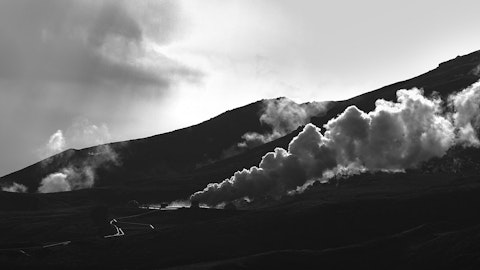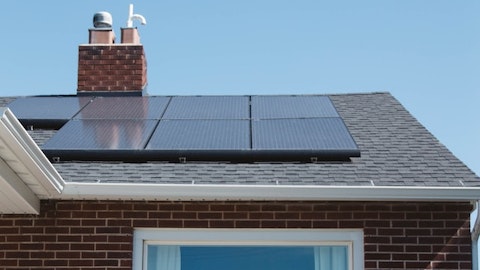Doron Blachar: The campaign, basically, we did split into two. On one hand, we drilled into our existing reservoir which is relatively shallow, which was okay to support the existing generation. But we also drilled to the deep reservoir. Deep, I mean around 10,000 feet, which is the deepest that we drilled, Ormat has drilled so far. And here, we get a very good reservoir. It has potential to increase the generation to the area of the 140 megawatts. We’ve seen that for a short period of time, but we need to make some adjustments to the power plant in order to be able to accept this strong resource, and we expect that to happen towards the end of the year.
Ryan Levine: Okay. And last quarter, you had highlighted some trade route redirection away from the Suez Canal. Is that still going on? Is there a way to quantify the impact to your business from margins or outlook?
Doron Blachar: The change of route just that we mentioned happened. And once it happened, it doesn’t change. Taking it into account, the shipping time is extended by two weeks. And once you align all your project or your manufacturing and delivery time to that, then it doesn’t impact anymore.
Operator: [Operator Instructions]. Your next question comes from the line Derek Podhaizer from Barclays.
Derek Podhaizer: Maybe just to continue the conversation on Kenya, could you provide us an update on the collections progress and whether you’re collecting in USD or not?
Assaf Ginzburg: As we mentioned, last year, we do expect improvement in the collection in Kenya. Over the quarter, and you will see it in our cash flow, our operating cash flow was one of the probably the strongest ever in Ormat’s history. I think it was close to $120 million as you see it on the presentation, and it was supported by a very good collection in Kenya. We collected in the last four months in addition to the common billing over $25 million, so almost $60 million in four months collection. I don’t think we’ve seen as much in the last few years. Dollar in Kenya, we do see a shift. They had a very successful bond offering for the government. And as a result, the government is in a much better situation. And I can tell you that we are very pleased with the situation Kenya [indiscernible]
Derek Podhaizer: Great. Appreciate the color. Maybe just expand on the $150 million you’re expecting in cash payments from the PTC ITC. We saw $29 million the first quarter, so maybe walk us through how that’ll step up for the remainder of the year just as you see it today.
Assaf Ginzburg: So just to explain, the $150 million is a cash item, not all of it will flow through the P&L. The two largest item in that are two tax equity transactions that we plan to make this year, one for Heber power plant that is already operating and one for the Beowawe power plant that is basically, as we speak, is starting to operate. So those combined will bring close to $100 million of that $150 million. In addition to that, we have two storage assets that are coming online this year. One has already came online which is East Flemington. And the second one, which is Pomona, which is very close to start operating in the next few weeks. So between those two, we expect to get roughly a $35 million to $40 million of cash.
So when you combine those, this is almost all of the $150 million. The remaining is PTC transfer mostly for the Heber power plant that we generated last year. And this year, it was generating around $4 million a quarter of PTCs over there. So when you think about it, some of it will flow through the P&L, all of the ITC storage will flow through the P&L. All of the PTCs transfer will flow through the P&L. And then the tax equity transactions on the geothermal, which is roughly $100 million, will flow through the P&L over the next eight, nine years evenly. But the most important thing is that we’re expecting $150 million in cash. When you combine it with a very strong EBITDA this year, it gets us to a point that Ormat almost is fully covering all of its needs including all the growth CapEx, which we haven’t been in that situation for years.
Derek Podhaizer: Right. Appreciate that. And then maybe just lastly on the CapEx. I noticed in the deck, it was revised up $550 million to $570 million for ’24. Looks like it’s all in storage, though, maybe some color on that, what’s driving the increase to your CapEx budget for the year?
Assaf Ginzburg: What we see on storage is two things that are really helping us pre-releasing project that you don’t see their names yet. The first thing is, as mentioned on the call before by Doron, battery prices are down close to 50% versus two years ago. So this enables us to release more projects. So that’s one thing that we are already pre-releasing projects. And second, PPA prices are almost at the level that they were before the IRA came in. So we are in a very strong demand for PPAs on one hand. And then battery prices are coming down, so we are pre-releasing more projects, some of which include buying some batteries for those projects, and therefore, you see some increase. But what will happen next in the next few quarters?
You will see us bringing more projects to you guys, maybe even as early as between now and year end. Maybe we’ll talk about in the Analyst Day. But there are more projects that are coming online, and therefore, we are increasing. We don’t see any increase in the current projects’ CapEx. Actually, we see a decrease, so it’s coming from new projects.
Operator: Your next question comes from the line Jeff Osborne from TD Cowen.
Jeff Osborne: Just three quick ones. I might have missed it, but did you provide an update or could you provide an update on the domestic storage battery supply that you are aiming to achieve. I think it was later this year or early next?
Assaf Ginzburg: At this point, it looks like the best route is to focus and buy Chinese-manufactured the batteries. Of course, we are talking to many manufacturers to see who will be the first one that will start producing in the US to try to titrate. We also see that there’s maybe a way to get the domestic content even when buying a Chinese batteries. It is still a very preliminary. But for example, it looks like Tesla does buy outside the US battery cells that are eligible or at least potentially eligible for their domestic content. So there are two routes just to be clear. One, to buy US-manufactured batteries. They don’t exist yet, and it will be probably slightly more expensive. And the second route is to see, is there a way to buy Chinese-manufactured batteries and to make enough work on them to make them eligible for the extra 10%.




